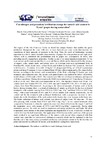Por favor, use este identificador para citar o enlazar este ítem:
http://www.alice.cnptia.embrapa.br/alice/handle/doc/1060019| Título: | Can nitrogen and potassium fertilization change the tartaric acid content in "Syrah" grapes during maturation? |
| Autor: | NASSUR, R. de C. M. R.  LIMA, P. C. P.   BARROS, J. Q.   BIASOTO, A. C. T.   PEREIRA, G. E.   SILVA, D. J.   |
| Afiliación: | Rita de Cássia Mirela Resende Nassur, Professor, Bahia State University, Juazeiro-BA, Brazil; Palloma Cavalcante Pereira Lima, Biology Student, Petrolina-PE. Brazil; Juliana Quixaba Barros, Biology Student, Petrolina-PE. Brazil; Aline Camarão Telles Biasoto, Researcher, Embrapa Semi-arid, Petrolina-PE, Brazil; GIULIANO ELIAS PEREIRA, CNPUV; Davi José Silva. |
| Año: | 2016 |
| Referencia: | IN: INTERNATIONAL SYMPOSIUM ON TROPICAL WINES, 5., 2016, Petrolina, PE. Book of abstracts...Petrolina, PE: Embrapa Semiárido, p. 37, 19 a 21 outubro, 2016. |
| Descripción: | The region of the São Francisco Valley in Brazil has unique features that enables the grape production throughout the year, with two or more harvests per year, event that increase the exportation of large amounts of nutrients to the fruit. Thus, the need of fertilization becomes important in order to obtain desirable characteristics of grapes for wine production and high yield. Tartaric acid is considered the predominant acid in grapes and consequently in wines, also providing specific organoleptic properties. |
| Thesagro: | Uva |
| Palabras clave: | Uva Syrah Maturação da uva Vale do São Francisco |
| Tipo de Material: | Resumo em anais e proceedings |
| Acceso: | openAccess |
| Aparece en las colecciones: | Resumo em anais de congresso (CNPUV)  |
Ficheros en este ítem:
| Fichero | Descripción | Tamaño | Formato | |
|---|---|---|---|---|
| Giulianop37BookofAbstractsISTW2016.pdf | 141,14 kB | Adobe PDF |  Visualizar/Abrir |








